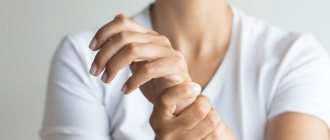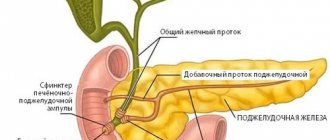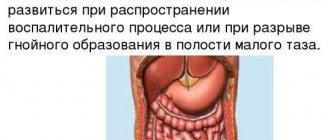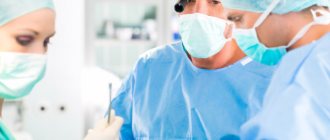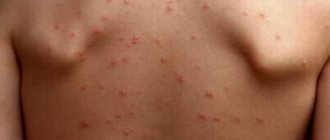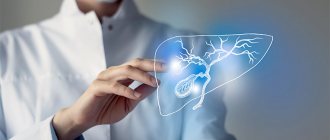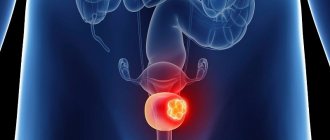Pain on the right side of the body may appear if the gallbladder, liver, stomach, pancreas or intestines are not in order. The most intense pain occurs with biliary colic and it is difficult to relieve. In order not to start a pathological process in the gallbladder, it is important to contact a gastroenterologist at the first painful sensation.
That is why it is necessary to know where a person’s gallbladder is located. And since pain in pathologies can radiate and be felt not only in the area of projection, you also need to know the functions of the gallbladder in the body in order to recognize the disease by other symptoms.
Causes of pain in the gallbladder
Pregnancy
The appearance of pain and discomfort in the gallbladder area is due to the development of cholestasis in pregnancy. Symptoms occur in the 3rd trimester of pregnancy and disappear in the first days of the postpartum period. Pain is caused by stagnation of bile in the biliary tract (BDT). In addition to pain, yellowness of the skin and mucous membranes and severe itching are noted. The urine becomes dark in color and the stool becomes gray.
Biliary dyskinesia
Functional disorders, which include gallstones, are the most common cause of pain in the gallbladder in children, young and middle-aged people. The nature and duration of the pain syndrome is determined by the type of motor impairment. With the hypermotor variant, the pain is cramping, strong, reminiscent of biliary colic. They appear 20-30 minutes after finishing a meal. Pain is often caused by psycho-emotional stress.
With the hypomotor variant of dyskinesia, aching or nagging pain in the right hypochondrium is disturbing. It begins 40-90 minutes after eating and is provoked by fatty foods and alcohol consumption. In contrast to hypermotor JP, the pain syndrome is longer lasting - up to several hours. It is accompanied by nausea, vomiting, a feeling of heaviness in the abdomen, alternating constipation and diarrhea.
Chronic cholecystitis
With this pathology, periodic pain is observed, localized on the right in the hypochondrium. They are provoked by eating large amounts of fatty foods, which leads to increased secretion of bile and increased load on the gallbladder. In women, symptoms worsen before menstruation. In chronic cholecystitis, the pain is dull or aching, not intense, combined with bitterness in the mouth, nausea, and stool instability.
Acute purulent cholecystitis
This disease is characterized by severe cramping pain in the gallbladder area that appears suddenly. To alleviate the condition, a person lies on his side and pulls his knees towards his stomach. A painful attack is accompanied by fever, sweating, and tachycardia. When inflammation passes into empyema of the gallbladder, pain reaches maximum intensity, body temperature rises to 40°C.
Cholangitis
In the acute form of inflammation of the bile ducts, sharp, severe pain is observed in the right hypochondrium. For them, irradiation is specific to the right shoulder, neck, and interscapular region. The symptom appears suddenly in combination with febrile fever and jaundice. There is no clear connection between pain and dietary errors or other typical factors. At the same time, nausea and vomiting, diarrhea, and weakness occur.
Chronic cholangitis is characterized by aching pain in the projection of the gallbladder. They are felt periodically, accompanied by heaviness in the hypochondrium on the right and a feeling of fullness in the epigastrium. The pain syndrome is not intense and does not require analgesics. In most cases, the pain disappears on its own after a few hours. The addition of general symptoms is typical: prolonged low-grade fever, increased fatigue.
Cholelithiasis
Pain syndrome is the main manifestation of the disease. A typical attack of cholelithiasis is called biliary colic. It develops with the abuse of fatty foods and emotional experiences. Suddenly, intense pain appears above the gallbladder and in the epigastrium. It radiates to the scapula, lower back, and precordial region. Often the pain is so strong that the person rushes about in bed and cannot find a position in which the pain subsides.
The attack lasts several hours. The pain is cramping in nature and is not relieved by conventional analgesics. For cholelithiasis, it is typical to increase body temperature simultaneously with the onset of pain. Clinical symptoms are supplemented by severe nausea and vomiting, and stool disorders. Chills and pale skin are noted.
Parasitic infestations
Pain in the right hypochondrium can be a sign of giardiasis. With this pathology, a mild pain syndrome is observed. There is no connection between pain and diet disorders or physical overexertion. The symptom is combined with unstable bowel movements, flatulence, and nausea. With parasitic infections, intoxication syndrome is also pronounced.
Postcholecystectomy syndrome
Symptoms of the disease occur after surgery to remove the gallbladder. Postcholecystectomy syndrome is characterized by recurrent pain attacks that develop for no apparent reason. The pain has a different character - cutting, spastic, dull, aching. The pain is accompanied by dyspeptic symptoms: belching, bitterness in the mouth, nausea, bloating. Diarrhea occurs with copious foul-smelling feces.
Gallbladder tumors
Benign polyps of the organ are characterized by scant symptoms. Periodically, dull pain is felt at the location of the gallbladder, which is not associated with food intake. In a small number of patients, the disease manifests itself as sharp pain and spasms in the right hypochondrium, which are provoked by eating fatty foods or physical activity.
In case of gallbladder cancer, pain syndrome is expressed at an advanced stage. There is a mild dull pain over the organ, which appears for no apparent reason. At first it bothers you sporadically, and then it becomes constant. The clinical picture is characterized by a progressive decrease in body weight, lack of appetite, and prolonged low-grade fever.
Organ function
The function of the gallbladder in the human body is to store bile, which comes continuously from the liver. Here the liver secretion settles, becomes more concentrated, and then, when food enters the digestive tract, it is reflexively released into the duodenum.
A person can live a full life without a bladder, then the question arises why a gallbladder is needed. The fact is that the liver constantly produces bile; the secretion enters the bladder through the ducts, where it lingers for several hours (until food arrives). Liver bile is golden yellow in color, its pH ranges from 7.3–8, and its relative density is 1.008–1.015.
In the gallbladder, bicarbonates are absorbed, due to which the pH level decreases to 6–7, and the density increases to 1.026–1.048, which means that such a secretion will better perform its tasks: stimulate the functioning of the intestines, pancreas, have a bacteriostatic effect, break down fats , promote the absorption of water-insoluble fatty acids, cholesterol, vitamins, neutralize pepsin and create conditions for the activation of pancreatic juice enzymes.
If the gallbladder is not functioning well, a cholecystectomy (removal) is performed. In this case, the liver secretion constantly enters the duodenum and, in the absence of food there, begins to affect the intestinal tissue. Since bile stimulates the secretion of pancreatic juice and gastric mucus, their production is also disrupted.
In the absence of a gallbladder, the digestion process slows down, and hence flatulence, dysbacteriosis, colitis, enteritis, and reflux.
Diagnostics
A careful collection of medical history and eating habits plays a major role in determining the cause of pain. During a physical examination, a gastroenterologist checks for cystic symptoms that indicate an inflammatory process. The diagnostic search involves a comprehensive laboratory and instrumental examination of the biliary system. The following methods are used:
- Ultrasound of the gallbladder.
According to sonography, the size and contours of the gallbladder and the condition of the bile ducts are assessed. During the examination, stones and adhesions may be noticed. To study the contractile activity of the organ, a test with a choleretic breakfast is indicated. - ERCP.
The technique of reverse contrasting of the bile ducts is necessary for detailed visualization of their condition, finding small stones that were not visible during sonography. ERCP is performed using an endoscope, so it is both a diagnostic and therapeutic method. - Duodenal sounding.
Obtaining several portions of bile is necessary for its microscopic and bacteriological analysis. An increased number of leukocytes and mucus are found in the bile. During bacterial culture, a mixed bacterial flora is usually found. - X-ray techniques.
A plain radiography of the abdominal cavity is performed to identify complications - calcification of the gallbladder wall, free gas under the diaphragm. To clarify the diagnosis, cholecystography, MSCT of the abdominal organs, and dynamic scintigraphy of the hepatobiliary system are recommended. - Laboratory research.
In the hemogram for inflammatory diseases of the gallbladder, leukocytosis and increased ESR are detected. A biochemical blood test is performed to look for signs of cholestasis (increased alkaline phosphatase and cholesterol levels) and to assess the content of direct bilirubin.
People's Councils
Traditional medicine suggests using herbal decoctions to relieve pain. Recommended herbs with choleretic and anti-inflammatory effects:
- calendula and chamomile flowers;
- corn silk;
- immortelle;
- tansy;
- peppermint;
- dandelion roots;
- wormwood;
- celandine;
- fennel fruits.
The medicinal plants are choleretic infusions; they can be purchased ready-made at the pharmacy.
The “blind probing” method consists of taking a spoonful of vegetable oil, Xylitol, Sorbitol on an empty stomach and maintaining a lying position on the right side for about an hour. This helps to free the bladder from accumulated bile and eliminate stagnation. There is advice: to empty the bladder after drinking herbal tea, lie on your left side and tap yourself on the right hypochondrium.
Pain syndrome in diseases of the biliary organs requires establishing a connection with stones, a type of dyskinesia, and inflammation. It is recommended that patients treat chronic foci of infection. Even after the bladder is removed, you must adhere to a diet and take medications.
Treatment
Help before diagnosis
For mild pain, indicating a chronic process, it is permissible to limit yourself to non-drug methods. The patient is given a detailed diet plan, which involves the exclusion of animal fats, extractives, and alcohol. The diet depends on the preservation of the biliary function of the bladder. To increase the volume of bile, mineral waters are prescribed. In case of an acute pain attack, you should go to the hospital as soon as possible.
Conservative therapy
Drug treatment is carried out for uncomplicated forms of gallbladder disease, without the risk of organ destruction. At the initial stage, antispasmodics and analgesics are used to relieve painful symptoms. Then etiopathogenetic therapy is selected, which may include several groups of drugs:
- Antibiotics
. For exacerbation of cholecystitis and cholangitis, broad-spectrum antibacterial drugs are used. To accelerate the elimination of bacterial toxins and endotoxins, treatment is supplemented with infusion therapy. - Choleretic agents
. After stopping the acute process, drugs are prescribed that improve the flow of bile. They are divided into 2 groups: cholekinetics, which stimulate the contractile activity of the gallbladder, and choleretics, which increase the volume of the water component of bile. - UDHC
. The use of ursodeoxycholic acid is one of the methods of non-surgical treatment of cholelithiasis. With long-term use (up to two years), the active substance dissolves stones and helps normalize the biochemical composition of bile.
After the elimination of acute inflammation, physiotherapeutic techniques are prescribed. For chronic cholecystitis, it is advisable to use reflexology, SMT therapy, and electrophoresis. It is effective to use decoctions of medicinal plants that have hepatoprotective and choleretic properties. Spa treatment at balneological resorts is recommended.
Cholecystectomy. Gallbladder stones
Lithotripsy
For calculous cholecystitis, methods of non-invasive crushing of stones are widely used. In gastroenterology, extracorporeal shock wave and contact lithotripsy are more often performed. This treatment is characterized by the absence of tissue trauma and a short rehabilitation period. Lithotripsy is only required for stones up to 2 cm in size.
What diseases of the biliary system are accompanied by pain?
Gallbladder pain is caused by:
- inflammatory process in cholecystitis and cholangitis;
- biliary dyskinesia (impaired contractility);
- cholelithiasis (the spelling “cholelithiasis” is erroneous, which can be checked using the International Classification);
- malignant tumors.
All of these diseases disrupt the function of bile transportation and cause disruption of the digestive process. This is accompanied by similar symptoms, differing only in intensity and course.
Inflammation affects the internal mucous membrane, causing an influx of blood and leukocytes
What questions can you ask the doctor at your appointment?
- Do I need surgery?
- Is it possible to dissolve stones?
- Why is it better not to dissolve stones?
- Is it possible to simply remove the stones and leave the bubble?
- How will my life change after cholecystectomy?
- Will there be dietary restrictions?
- Will it hurt after the surgery?
- What kind of anesthesia will it be?
- When can I eat fatty heavy foods and alcohol?
- Are dressings necessary after discharge from the hospital?
You can contact the clinic of coloproctology and minimally invasive surgery for diagnosis and treatment of gallstone disease. Thanks to modern operating rooms and highly qualified staff, the clinic provides all types of treatment for gallstone disease, including robotic surgeries.
Treatment under the compulsory medical insurance policy is possible.
Sign up for a consultation and receive quality treatment as soon as possible.
Complications
Problems of the biliary system can lead to serious consequences:
- Phlegmon is a disruption in the flow of blood to a diseased organ, which leads to the death of the walls and the danger of rupture.
- Jaundice occurs when there is an excess amount of bilirubin pigment in the body, caused by obstructions in the ducts. Leads to yellowing of the skin and whites of the eyes.
- Pancreatitis is inflammation of the pancreas. In many cases, it is the stones that become its cause; fortunately, this form of pathology is far from the most dangerous. With pancreatitis, the upper abdomen may hurt in the middle or on the left.
- Sepsis is a general infection of the body by microbes. It happens due to the entry of pathogenic bacteria from the ducts into the blood. Its symptoms are high fever, low blood pressure, chills, and an increase in the number of white blood cells.
- Intestinal obstruction can be caused by a large stone entering the small intestine.
- Fistulas are openings between adjacent hollow organs. Appear in cases where the stone damages the soft tissue of the duct, small intestine or stomach. If the integrity of the peritoneum is compromised, this leads to peritonitis.
How does the liver work?
The liver is the largest gland in humans. It is located in the upper floor of the abdominal cavity on the right. It consists of two main lobes - right and left, which in turn are divided into 8 segments.
In an adult, it weighs about 1/40 of the total body weight (approximately 1.6 kg in men and 1.2 kg in women). The liver has a dual blood supply: approximately 80% of the blood entering the liver comes from the portal vein (venous blood collected from all unpaired abdominal organs), the rest (oxygenated arterial blood) comes from the hepatic artery. Having entered the portal of the liver, both vessels give rise to multiple branching smaller vessels. At the exit from the liver, 3-4 hepatic veins are formed, which flow into the inferior vena cava.
The main structural unit of the liver is the hepatic lobule, which consists of liver cells - hepatocytes. This cell is one of the most important biochemical laboratories of the body. The hepatocyte takes part in the metabolism of proteins, carbohydrates, fats, bile acids, and vitamins. Neutralizes toxic substances coming from the intestines, followed by the release of associated products into the intestinal lumen. An important function of the hepatocyte is the synthesis of bile, which is involved in digestion.
Postoperative period
In case of an uncomplicated course of the postoperative period, early activation of the patient is practiced, 3-4 hours after the operation. Eating is allowed on the second day. Discharge from the hospital occurs within 3-4 days, and depends on the individual threshold of pain sensitivity. Removal of sutures is not required, as skin wounds are sutured with cosmetic sutures and absorbable sutures.
A return to normal lifestyle and physical activity is possible within 10–14 days, after complete healing of skin wounds.
Appearance after laparoscopic cholecystectomy:
How are the bile ducts arranged and how do they work?
The bile ducts are a system of ducts that originate from hepatocytes and gradually gather into interlobular, segmental and right and left lobar ducts, which unite into the common hepatic duct.
One of the stages of bile removal is its accumulation in the reservoir - the gallbladder. The main function of the gallbladder is to concentrate bile and release it into the lumen of the duodenum during digestion. The volume of this organ is about 80 ml.
The gallbladder is located on the lower surface of the liver. It is a hollow muscular organ, externally covered with a serous membrane and internally lined with mucous membrane. The structure of the gallbladder is divided into the bottom, body and neck of the bladder, which passes into the cystic duct.
